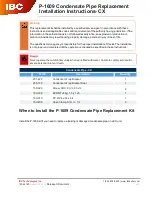
18
5- VENTILATION & COMBUSTION AIR
Room Cubic Feet Volume
#
Sections
Input
BTU/HR
Standard
Method
Known Air Infiltration Rate Method (ACH - Air Changes Per Hour)
0.1
0.2
0.3
0.4
0.5
0.6
3
59,000
2950
12390
6195
4130
3098
2478
2065
4
92,500
4625
19425
9712.5
6475
4856
3885
3238
5
120,000
6000
25200
12600
8400
6300
5040
4200
6
149,000
7450
31290
15645
10430
7823
6258
5215
7
175,000
8800
36960
18480
12320
9240
7392
6160
8
205,000
10250
43050
21525
14350
10763
8610
7175
9
235,000
11750
49350
24675
16450
12338
9870
8225
Table 5-1 - Space With Boiler Only
5.1 Requirements
Provide combustion air and ventilation air in accordance
with the section “Air for Combustion and Ventilation,” of the
National Fuel Gas Code, ANSI Z223.1/NFPA 54, or Sections
8.2, 8.3 or 8.4 of Natural Gas and Propane Installation
Code, CAN/CSA B149.1, or applicable provisions of local
building codes.
Provide make-up air where exhaust fans, clothes dryers,
and kitchen ventilation equipment interfere with proper
operation. If inadequate makeup air is suspected it is
always acceptable to add additional ventilation.
National Fuel Gas Code recognizes several methods
of obtaining adequate ventilation and combustion air.
Requirements of the authority having jurisdiction may
override these methods.
• Engineered Installations. Must be approved by
authority having jurisdiction.
• Mechanical Air Supply. Provide minimum of 0.35 cfm
per [(BTU/HR)/1,000] for all appliances located within
space. Additional requirements where exhaust fans
installed. Interlock each appliance to mechanical air
supply system to prevent main burner operation when
mechanical air supply system not operating.
• All Indoor Air. Calculate minimum volume for all
appliances in space. Use a different method if
minimum volume not available.
A. Standard Method. Cannot be used if known air
infiltration rate is 0.40 air changes per hour. See
Table 3 for space with boiler only. Use equation for
multiple appliances.
Volume ≥ 50 ft
3
x Total Input [(
BTU/HR
)/1,000]
B.
Known Air Infiltration Rate. See Table 5-1 for
space with boiler only. Use equation for multiple
appliances. Do not use an air infiltration rate
(ACH) greater than 0.60.
Volume ≥
21 ft
3
⁄ACH x Total Input
Refer to National Fuel Gas Code for opening
requirements between connected indoor spaces.
• All Outdoor Air. Provide permanent opening(s)
communicating directly or by ducts with outdoors.
A. Two Permanent Opening Method. Provide opening
commencing within 12 inches of top and second
opening commencing within 12 inches of bottom of
enclosure.
Direct communication with outdoors or
communicating through vertical ducts. Provide
minimum free area of 1 in² per 4 [(BTU/
hr)/1,000] of total input rating of all appliances
in enclosure.
Communicating through horizontal ducts.
Provide minimum free area of 1 in² per 2
[(BTU/HR)/1,000] of total input rating of all
appliances in enclosure.
B. One Permanent Opening Method. Provide opening
commencing within 12 inches of top of enclosure.
Provide minimum clearance of 1 inch on sides/back
and 6 inches on front of boiler (does not supersede
clearance to combustible materials).
• Refer to National Fuel Gas Code for additional
requirements for louvers, grilles, screens and air ducts.
• Combination Indoor and Outdoor Air. Refer to National
Fuel Gas Code for application information.
National Gas and Propane Installation Code Requires
providing air supply in accordance with:
• Section 8.2 and 8.3 when combination of appliances
has a total input of up to and including 400 [(BTU/
hr)/1,000] (120 kW).
• Section 8.4 when combination of appliances has total
input exceeding 400 [(BTU/hr)/1,000] (120 kW).
• Refer to Natural Gas and Propane Installation Code
for specific air supply requirements for enclosure
or structure where boiler is installed, including air
supply openings and ducts.
WARNING
Asphyxiation Hazard! Provide enough air openings
to boiler/combustion area to dilute flue gases
and allow for consistent, guality combustion.
Do not obstruct air openings. Follow instructions
below, to maintain adequate combustion air.
Failure to follow these instructions good result in
ignition failure, overheating, carbon monoxide, and
accumulation of flue gases.
!
[(BTU/HR)/1,000]
PN 240012787 Rev. C [11/15/2020]
















































